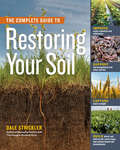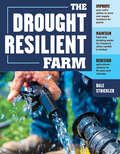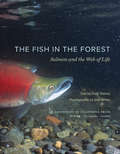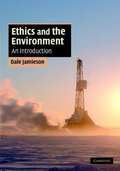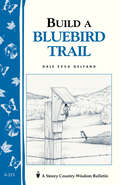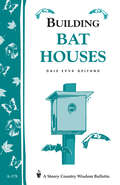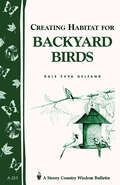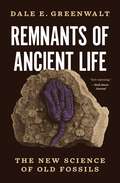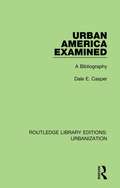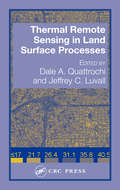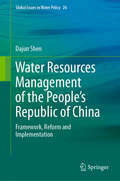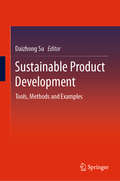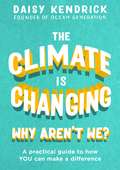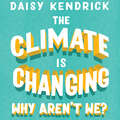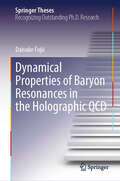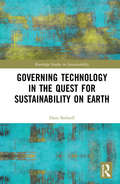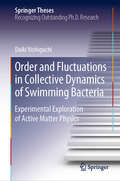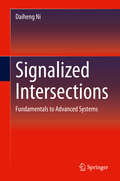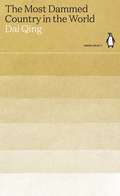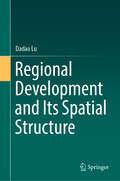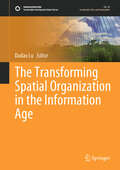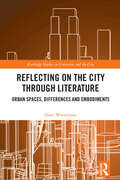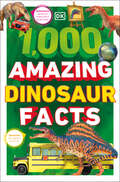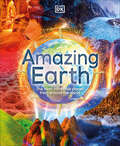- Table View
- List View
The Complete Guide to Restoring Your Soil: Improve Water Retention and Infiltration; Support Microorganisms and Other Soil Life; Capture More Sunlight; and Build Better Soil with No-Till, Cover Crops, and Carbon-Based Soil Amendments
by Dale StricklerHealthy soil is key to sustaining life on Earth. While more and more people are starting to see the need for soil restoration, there is very little understanding of just how it can be accomplished. There is a rapidly emerging demand for a &“how to&” manual for soil restoration. Dale Strickler is an expert on building healthy soil and restoring degraded soil, and in The Complete Guide to Restoring Your Soil, he presents the science of soil, along with proven methods of restoring depleted soil and agricultural practices from around the world that continue to build soil, rather than cause it to deteriorate. Strickler provides a solid foundation in the science of healthy soil, explaining how soil has become so degraded over time and the dire consequences for the human species, not just in terms of food scarcity but also the social, health, and environmental consequences of growing food in poor soil. He addresses the chemical, physical, and biological principles behind soil function, and presents actual farming practices that can be used to regenerate soil, techniques and strategies for remediating contaminated soil, and agriculture systems both past and present that functioned to build soil, such as the ancient chinampas systems of Mexico and the permaculture systems of today.
The Drought-Resilient Farm: Improve Your Soil’s Ability to Hold and Supply Moisture for Plants; Maintain Feed and Drinking Water for Livestock when Rainfall Is Limited; Redesign Agricultural Systems to Fit Semi-arid Climates
by Dale StricklerRainfall levels are rarely optimal, but there are hundreds of things you can do to efficiently conserve and use the water you do have and to reduce the impact of drought on your soil, crops, livestock, and farm or ranch ecosystem. Author Dale Strickler introduces you to the same innovative systems he used to transform his own drought-stricken family farm in Kansas into a thriving, water-wise, and profitable enterprise, maximizing healthy cropland, pasture, and water supply. Ranging from simple, short-term projects such as installing rain-collection ollas to long-term land-management planning strategies, Strickler’s methods show how to get more water into the soil, keep it in the soil, and help plants and livestock access it. This publication conforms to the EPUB Accessibility specification at WCAG 2.0 Level AA.
The Fish in the Forest
by Dale StokesThe Fish in the Forest is an elegantly written, beautifully illustrated exploration of the complex web of relationships between the salmon of the Pacific Northwest and the surrounding ecosystem. Dale Stokes shows how nearly all aspects of this fragile ecosystem--from streambeds to treetops, from sea urchins to orcas to bears, from rain forests to kelp forests--are intimately linked with the biology of the Pacific salmon. Illustrated with 70 stunning color photographs by Doc White, The Fish in the Forest demonstrates how the cycling of nutrients between the ocean and the land, mediated by the life and death of the salmon, is not only key to understanding the landscape of the north Pacific coast, but is also a powerful metaphor for all of life on earth.
Ethics and the Environment: An Introduction
by Dale JamiesonThis book is an introduction to the philosophical issues involved in this important question, focussing primarily on ethics but also encompassing questions in aesthetics and political philosophy. Topics discussed include the environment as an ethical question, human morality, meta-ethics, normative ethics, humans and other animals, the value of nature, and nature's future.
Build a Bluebird Trail: Storey's Country Wisdom Bulletin A-213
by Dale Evva GelfandConservationists across North America are working to help protect and support bluebirds, and you can do your part by creating a bluebird trail. This is simply a series of nesting boxes (anywhere from a few to a few thousand) set about 300 feet apart along a prescribed route. Dale Gelfand tells you what you need to know about bluebirds and their habits, and she shows you how to create and monitor an effective bluebird trail with well-designed nesting boxes.
Building Bat Houses: Storey's Country Wisdom Bulletin A-178 (Storey Country Wisdom Bulletin Ser.)
by Dale Evva GelfandSince 1973, Storey's Country Wisdom Bulletins have offered practical, hands-on instructions designed to help readers master dozens of country living skills quickly and easily. There are now more than 170 titles in this series, and their remarkable popularity reflects the common desire of country and city dwellers alike to cultivate personal independence in everyday life.
Creating Habitat for Backyard Birds: Storey's Country Wisdom Bulletin A-215 (Storey Country Wisdom Bulletin Ser.)
by Dale Evva GelfandSince 1973, Storey's Country Wisdom Bulletins have offered practical, hands-on instructions designed to help readers master dozens of country living skills quickly and easily. There are now more than 170 titles in this series, and their remarkable popularity reflects the common desire of country and city dwellers alike to cultivate personal independence in everyday life.
Remnants of Ancient Life: The New Science of Old Fossils
by Dale E. GreenwaltThe revolution in science that is transforming our understanding of extinct lifeWe used to think of fossils as being composed of nothing but rock and minerals, all molecular traces of life having vanished long ago. We were wrong. Remnants of Ancient Life reveals how the new science of ancient biomolecules—pigments, proteins, and DNA that once functioned in living organisms tens of millions of years ago—is opening a new window onto the evolution of life on Earth.Paleobiologists are now uncovering these ancient remnants in the fossil record with increasing frequency, shedding vital new light on long-extinct creatures and the lost world they inhabited. Dale Greenwalt is your guide to these astonishing breakthroughs. He explains how ancient biomolecules hold the secrets to how mammoths dealt with the bitter cold, what colors dinosaurs exhibited in mating displays, how ancient viruses evolved to become more dangerous, and much more. Each chapter discusses different types of biomolecules and the insights they provide about the physiology, behavior, and evolution of extinct organisms, many of which existed long before the age of dinosaurs.A marvelous adventure of discovery, Remnants of Ancient Life offers an unparalleled look at an emerging science that is transforming our picture of the remote past. You will never think of fossils in the same way again.
Urban America Examined: A Bibliography (Routledge Library Editions: Urbanization #1)
by Dale E. CasperOriginally published in 1985 Urban America Examined, is a comprehensive bibliography examining the urban environment of the United States. The book is split into sections corresponding to the four main geographic regions of the country, looking respectively at research conducted in the East, South, Midwest and West. The book provides a broad cross section of sources, from books to periodicals and covers a range of interdisciplinary issues such as social theory, urbanization, the growth of the city, ethnicity, socialism and US politics.
Thermal Remote Sensing in Land Surface Processing
by Dale A. Quattrochi; Jeffrey C. LuvallAlthough remote sensing is recognized as a powerful tool, less attention has been given in the past to the use of thermal, and especially thermal infrared (TIR) remote sensing. TIR data is useful for understanding the fluxes and redistribution of materials as a key aspect of land surface processes and land-atmosphere inter-relationships. This book
Water Resources Management of the People’s Republic of China: Framework, Reform and Implementation (Global Issues in Water Policy #26)
by Dajun ShenThis book explores water resources management issues in China and possible solutions. It analyzes a wide range of general and specific topics, providing case studies and a balanced review of the past and present situation as well as future developments. The book begins with a general introduction and an overview of hydrology, water resources, and development issues in China. It then presents a management framework, including a management system, management institutions, river basin management, water pricing, water rights, and groundwater management, and discusses its implementation, covering water resources allocation and regulation in the Yellow River, integrated water affair management reforms, and agricultural water management in northern China. The last section focuses on the current reforms and hot topics, with strong emphasis on stringent water resource strategies applied to the river and lake principle system, recycled water use and water resources asset management, as well as climate change impacts, and concludes with a summary of the many changes in the water sector in China and a look at the road ahead and the areas that still need to be reformed.
Sustainable Product Development: Tools, Methods and Examples
by Daizhong SuThis book offers a comprehensive review of sustainability and product design, providing useful information on the relevant regulations and standards for industries to meet increasing market demands for eco-products, while reducing their impact on the environment. The examples and methods presented allow readers to gain insights into sustainable products. The authors also explain how to develop products with sustainability features by applying tools and methods for sustainable design and manufacture. These tools/methods include• Regulations/directives related to sustainable product development• Popular lifecycle analysis software packages• Environmental and social lifecycle impact assessment methods• Lifecycle inventory databases• Eco-point and eco-accounting infrastructure• ICT and traceability technologies for sustainable product development• Sustainable design and manufacture• Integrated approach for sustainable product developmentA description of each sustainability tool is accompanied by easy-to-understand guidelines as well as sustainable product development methods. Five different case studies are also presented to illustrate how to apply the tools and methods into the development of real sustainable products.In view of the increasing pressure on industries to meet the, sometimes conflicting, demands of the market and environment, this book is a valuable resource for engineers and managers in manufacturing companies wishing to update their knowledge of sustainable product development. It is also suitable for researchers and consultants who are involved or interested in sustainable product development, as well as for students studying sustainable development, production, and engineering management.
The Climate is Changing, Why Aren't We?: A practical guide to how you can make a difference
by Daisy Kendrick'An inspirational and motivational must-read, packed with practical tips to push for positive change' Zanna van DijkThe climate is changing, so why aren't we? After all, we are the generation of change. The severity of climate change leaves no one indifferent. The Climate is Changing, Why Aren't We? will not try to convince you that climate change exists - we know that. It offers easy to understand insights into the structures that suffocate our future, while upholding a sense of optimism and humanising the climate story. From the clothes you buy, plastics you use and food you eat, to knowing how to harness the power of social media and technology to get our voices heard and demand climate action, Daisy Kendrick, founder of Ocean Generation, weaves together inspirational stories, shocking statistics and easy green switches to make in your everyday life to tackle climate change on an individual level. The Climate is Changing, Why Aren't We? will help to grant future generations the rights they deserve.
The Climate is Changing, Why Aren't We?: A practical guide to how you can make a difference
by Daisy Kendrick'An inspirational and motivational must-read, packed with practical tips to push for positive change' Zanna van DijkThe climate is changing, so why aren't we? After all, we are the generation of change. The severity of climate change leaves no one indifferent. The Climate is Changing, Why Aren't We? will not try to convince you that climate change exists - we know that. It offers easy to understand insights into the structures that suffocate our future, while upholding a sense of optimism and humanising the climate story. From the clothes you buy, plastics you use and food you eat, to knowing how to harness the power of social media and technology to get our voices heard and demand climate action, Daisy Kendrick, founder of Ocean Generation, weaves together inspirational stories, shocking statistics and easy green switches to make in your everyday life to tackle climate change on an individual level.The Climate is Changing, Why Aren't We? will help to grant future generations the rights they deserve.
The Climate is Changing, Why Aren't We?: A practical guide to how you can make a difference
by Daisy Kendrick'An inspirational and motivational must-read, packed with practical tips to push for positive change' Zanna van DijkThe climate is changing, so why aren't we? After all, we are the generation of change. The severity of climate change leaves no one indifferent. The Climate is Changing, Why Aren't We? will not try to convince you that climate change exists - we know that. It offers easy to understand insights into the structures that suffocate our future, while upholding a sense of optimism and humanising the climate story. From the clothes you buy, plastics you use and food you eat, to knowing how to harness the power of social media and technology to get our voices heard and demand climate action, Daisy Kendrick, founder of Ocean Generation, weaves together inspirational stories, shocking statistics and easy green switches to make in your everyday life to tackle climate change on an individual level. The Climate is Changing, Why Aren't We? will help to grant future generations the rights they deserve.
Dynamical Properties of Baryon Resonances in the Holographic QCD (Springer Theses)
by Daisuke FujiiThis book focuses on the study of the dynamical properties of hadron resonances, especially their transition processes by electromagnetic and strong interactions, by using the holographic quantum chromodynamics (QCD) model. Understanding the nature of hadrons leads to revealing non-perturbative phenomena that are prominent in the low-energy region of QCD. However, there remain many open questions regarding the nature of resonant states. Holographic QCD is one of the most powerful methods to elucidate non-perturbative phenomena in QCD. We will attempt to investigate the dynamical properties of hadron resonances using the Sakai-Sugimoto model, which has achieved much success in the study of hadron physics. In particular, we studied the transition process of hadrons through the calculation of the form factors of them employing the approach of holographic QCD. The book contains a systematic review of the treatment of hadron physics by the Sakai-Sugimoto model. It further covers how to calculate the form factors of baryons through the calculation of the n-point function from holographic QCD. It also includes remarks on the modern understanding of hadron physics. The method of collective coordinate quantization of solitons—Skyrmion and Instanton—is also explained in a concise manner. These are useful not only for students and young researchers interested in this field.
Governing Technology in the Quest for Sustainability on Earth (Routledge Studies in Sustainability)
by Dain BolwellGoverning Technology in the Quest for Sustainability on Earth explores how human technologies can be managed to ensure the long-term sustainability of our species and of other life forms with which we share this world. It analyses human impact, the discourses of environmentalism and issues of economics, history and science. As these variables are complex, drawing on issues from the social, physical and life sciences as well as the humanities, Dain Bolwell uses an interdisciplinary approach to investigate these concepts and their related public policies. Exploring three major existing and emerging technologies – chemical herbicides, nuclear-electric power generation, and robotics and artificial intelligence – the book demonstrates the multifaceted and complicated nature of the grand challenges we face and draws out the measures required to effect sustainability in the wider political sphere. Exploring how we can govern technology most effectively to ensure a long term and sustainable future, this book will be of great interest to students and researchers of environmental studies, science and technology and environmental law and policy.
Order and Fluctuations in Collective Dynamics of Swimming Bacteria: Experimental Exploration of Active Matter Physics (Springer Theses)
by Daiki NishiguchiThis thesis focuses on experimental studies on collective motion using swimming bacteria as model active-matter systems. It offers comprehensive reviews of state-of-the-art theories and experiments on collective motion from the viewpoint of nonequilibrium statistical physics. The author presents his experimental studies on two major classes of collective motion that had been well studied theoretically. Firstly, swimming filamentous bacteria in a thin fluid layer are shown to exhibit true, long-range orientational order and anomalously strong giant density fluctuations, which are considered universal and landmark signatures of collective motion by many numerical and theoretical works but have never been observed in real systems. Secondly, chaotic bacterial turbulence in a three-dimensional dense suspension without any long-range order as described in the first half is demonstrated to be capable of achieving antiferromagnetic vortex order by imposing a small number of constraints with appropriate periodicity. The experimental results presented significantly advance our fundamental understanding of order and fluctuations in collective motion of motile elements and their future applications.
Signalized Intersections: Fundamentals to Advanced Systems
by Daiheng NiThis textbook introduces the basics principles of intersection signalization including need studies, signal phasing, sequencing, timing, as well as more advanced topics such as detectors, controllers, actuated control schemes, and signal coordination. The book covers a variety of topics critical to the set up and operation of intersections controlled by traffic signals. Professor Ni imparts a basic understanding of how intersections work, what justifies intersection signalization, how to properly design phasing and timing plans for intersections, what is needed to run traffic-responsive signals, the workings of traffic controller cabinets, and how to set up signal coordination at multiple intersections—competencies essential to transportation professionals in charge of traffic operation at federal, state, and local levels. Aimed at students in transportation engineering programs with a focus on intersection signalization, the book is also ideal for researchers of traffic dynamics and municipal civil and transportation engineers.
The Most Dammed Country in the World (Green Ideas)
by Dai QingIn twenty short books, Penguin brings you the classics of the environmental movement.The courageous, unflinching speeches and writings collected in The Most Dammed Country in the World detail the devastating human and environmental cost of China's economic rise.Over the past 75 years, a new canon has emerged. As life on Earth has become irrevocably altered by humans, visionary thinkers around the world have raised their voices to defend the planet, and affirm our place at the heart of its restoration. Their words have endured through the decades, becoming the classics of a movement. Together, these books show the richness of environmental thought, and point the way to a fairer, saner, greener world.
Regional Development and Its Spatial Structure
by Dadao LuThis book describes the progress and prominent theories of regional development research in the past decades, especially in the past decade, discusses the industrial structure, spatial structure, resources, and environment, as well as a series of practical issues, and reveals the general characteristics of spatial structure evolution in the process of regional development. The research on the issues of regional development has become the frontier of relevant disciplines since the 1950s, and much progress has been made in the process of solving practical problems in social and economic development. This book provides an in-depth and systematic demonstration of the "point-axis system" theory of regional exploitation and development as well as the T-shaped structure of China's regional economic action in theory and practice and discusses the impact of location differential rent, restricted accessibility, technological innovation, etc., on regional development theoretically. This book is used as a reference for planning, scientific research, and teaching personnel in territorial expansion, regional economy, human geography, etc.
The Transforming Spatial Organization in the Information Age (Sustainable Development Goals Series)
by Dadao LuThis book provides a critical account, a state-of-the-art review, as well as novel research methods of information technology development and the corresponding changes of socio-economic spatial organization in China.With the rapid development of the Internet over the past three decades, the development of information technology and its impact on social economy have become an important frontier issue of human and economic geography. Actually, the influence of information technology is complex and dynamic, involving almost all aspects of socio-economic activities and our daily life. It is also influencing the methods and disciplines that we use to understand it. In general, industrial development and regional management and innovation are the core contents of socio-economic spatial organization. Therefore, changes in industrial clusters, transportation logistics, regional development and innovation, urban planning and management, and rural development under the background of the information age were analysed to understand the relationship among information revolution, socio-economic spatial organization, and human and economic geography.Primarily intended for scholars and graduate students across a range of disciplines, such as geography, urban-rural planning, information science, urban science, economics and sociology, and people engaged in regional planning, urban management and information management, this book proves to be an innovative and up-to-date resource.
Reflecting on the City Through Literature: Urban Spaces, Differences and Embodiments (Routledge Studies in Urbanism and the City)
by Daan WesselmanThis book develops and demonstrates an interdisciplinary method that reads literary works as a way of thinking about the city. Literary works do not only provide reflections of the city – depictions of the city as an aesthetically compelling setting – but the literary reflection of the city also offers a critical reflection on the city. How can spatial difference be conceived in cities that are changing beyond the form of the classical modern metropolis of the early 20th century? How can one think of the relation between individual urban subjects and their urban environment, when neither spaces nor discourses of the city provide them with an answer to the question where they might "belong"? How does the human body interact with its urban surroundings, and how should technological mediations be thought of? This book approaches these questions through analysing literary texts, focusing on concepts like heterotopia, non-place and the posthuman. This book will be of interest to interdisciplinary scholars and students of the city, particularly in the fields of Urban Studies, Literary Studies, Geography, and Architecture.
1,000 Amazing Dinosaurs Facts: Unbelievable Facts About Dinosaurs
by DKAstonish your friends and family with this incredible collection of mind-boggling facts about the scariest animals ever to walk the Earth. This unbelievably fascinating dinosaur book for children will teach you all you need to know about prehistoric animals, like which dinosaur had the sharpest teeth, the longest claws, the smallest brain, the largest droppings, and lots more! Did you know that the largest dinosaur was longer than a tennis court but its babies were no bigger than a newborn human baby? That the smallest dinosaur weighed less than a teaspoon of sugar? Or that the largest flying reptile was as tall as a giraffe, with wings the size of a small plane? Children aged 9+ will love all these facts and more, presented either with jaw-dropping CGI illustrations or eye-popping photography – plus additional boxes feature diagrams that make information easy to understand. Celebrate your child's curiosity as they explore:- 1,000 jaw-dropping, mind-blowing facts that will be sure to wow family and friends. - Stunning CGI graphics, fun visual comparisons, and diagrams make stats and facts easy to understand.- Science boxes are illustrated with engaging diagrams.- Photo stories feature additional incredible stories and comparisons.In 1,000 Amazing Dinosaur Facts children can discover the fastest, the slowest, the deadliest, and the downright weirdest dinosaurs ever to roam the planet! This book of mind-blowing dinosaur facts will make the ideal gift for kids who love all things prehistoric, giving a real sense of the colossal scale of dinosaurs and how and where they lived.More in the SeriesIf you like 1,000 Amazing Dinosaur Facts then why not complete the collection? Dive into disgusting facts with 1,000 Amazing Gross Facts and discover the secret science of everything icky and sticky.
Amazing Earth: The Most Incredible Places From Around The World (DK Amazing Earth)
by Anita Ganeri DKAn exhilarating guided tour around the most amazing places on Earth, perfect for young adventurers with big imaginations! Award-winning children&’s author Anita Ganeri takes curious kids who love learning to the most incredible locations in the world. This science book for kids includes breathtaking images and mind-blowing facts about our majestic home — Earth! Turn the pages to discover natural wonders, stunning vistas and other jaw-dropping places from around the world. Inside the pages of this book about Earth, you&’ll discover: • Over 100 far-flung locations around the globe with areas so incredible you&’ll barely be able to believe they are real! • Illustrations that explain key natural phenomena and reveal exciting, in-depth details about some of the locations you&’ll explore. • A world map showing all the places together, and locator maps show where each site is in the world. • A foreword by Steve Backshall MBE – BAFTA and Emmy-winning English naturalist, explorer, philanthropist, author, and television presenterMount Everest and the Eiffel Tower are two of the most famous places to see on earth, but what if we told you our planet has more to offer? From waterfalls that look like they are on fire to a cave filled with twinkling blue glow worms and a bright pink lake, explore the most unbelievable, unusual and incredible places on Earth! Beautiful, dazzling images and information explores why each place is unique. Delve into the science, geology, flora and fauna, as well as the historical or cultural significance of each of these natural wonders! It is perfect for children age 7 to cultivate a lifelong curiosity about the natural sciences and the wonders of the world around them.
